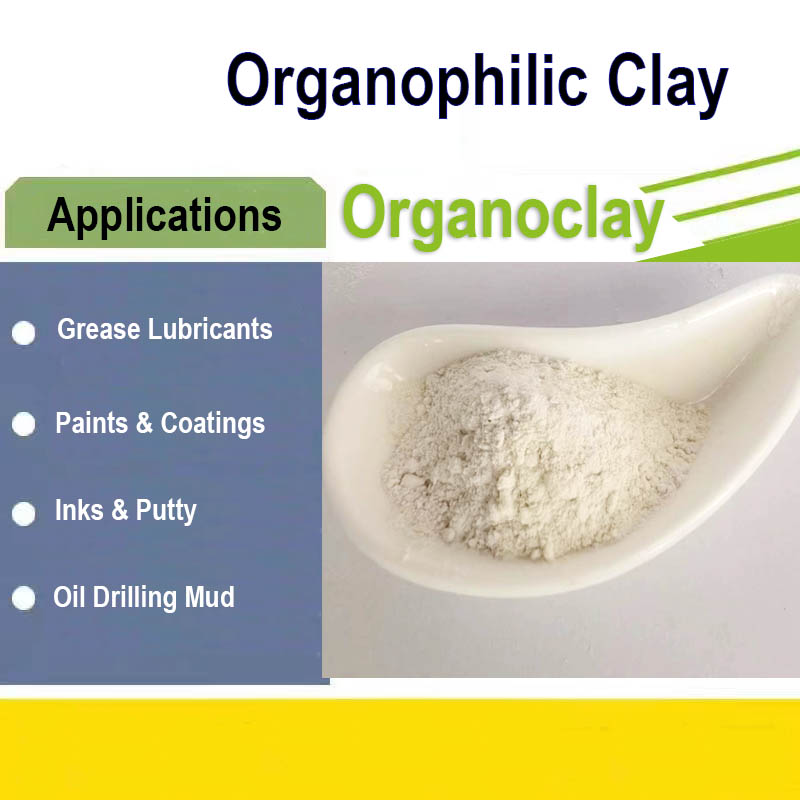Organoclay u boji kao suspendirajuće sredstvo
Organoclay in Paint : Povećanjem viskoznosti boje, organska glina pomaže u postizanju željenog tečenja i svojstva izravnavanja. Ova kontrola viskoznosti neophodna je za nanošenje boja, budući da utječe na čimbenike kao što je mogućnost četkanja, otpornost na kapanje, i formiranje filma. Prisutnost organogline omogućuje gušću konzistenciju boje, omogućujući bolju kontrolu tijekom primjene i smanjujući pojavu kapanja ili curenja.
Organoclay se može koristiti u raznim vrstama boja, uključujući sustave na bazi vode i otapala, pružanje stabilnosti u različitim medijima. Ova prilagodljivost čini Organoclay preferiranim izborom za proizvođače boja koji traže pouzdana suspendirajuća sredstva.
Organoclay in Paint & Premazi
Organoclay je vrijedna komponenta u formuliranju boja i premaza na bazi vode i otapala. Njegova uporaba u postizanju stabilnih emulzija doprinosi poboljšanoj stabilnosti, reologija, i ukupnu izvedbu konačnog proizvoda boje.
Organoclay u bojama i premazima na bazi vode
Voda je uobičajeni medij koji se koristi u bojama na bazi vode, a održavanje odgovarajuće razine pH bitno je za optimalnu učinkovitost. Tipično, pH raspon od 7.0 do 8.0 smatra se idealnim za boje na bazi vode. Organoklina se može dispergirati u vodi unutar tog pH raspona.
Tijekom procesa proizvodnje boje, raspršivanje sastojaka velikom brzinom tijekom razdoblja od 20 do 30 minuta je često potrebno. Ovo raspršivanje velikom brzinom pomaže u razbijanju nakupina i postizanju homogene smjese.
Kod formuliranja boja na bazi vode, emulzije se obično koriste za raspršivanje veziva i drugih komponenti. Pravilno miješanje emulzija bitno je za osiguranje stabilnosti i učinkovitosti boje. Korištenje organogline u bojama na bazi vode omogućuje formulatorima naknadnu korekciju. Prilagodbe se mogu izvršiti ugradnjom dodatnih aditiva ili modificiranjem količine organogline kako bi se postigli željeni rezultati.
Boje i premazi na bazi otapala
Boje i premazi na bazi otapala tekući su zaštitni slojevi koji se prvenstveno sastoje od organskih spojeva. Naširoko se koriste za zaštitu raznih materijala’ površine od korozije, pružajući trajnost i estetsku privlačnost. Bentonitna organska glina može ponuditi vrijedne prednosti u formulacijama boja na bazi otapala, posebno u pogledu zaštite od vremenskih uvjeta i pokrivanja kvarova.
Bentonit organoglina služi kao punilo, pomaže u popunjavanju malih nesavršenosti, pukotine, ili površinske nepravilnosti, što rezultira glatkijim i estetski ugodnijim završetkom. Organoclay služi kao dragocjeno disperzijsko sredstvo u bojama i premazima na bazi otapala, posebno u primjenama koje uključuju akrilnu smolu. Ravnomjerno raspršuje akrilnu smolu kroz formulaciju boje za jednoliku raspodjelu.
Studije o organoglini u materijalima za lakiranje
Čvrstoća premaza na udar odnosi se na njegovu sposobnost da se odupre oštećenjima i deformacijama kada je izložen vanjskim silama, poput udara ili sudara. Premazi od polistirena naširoko se koriste u raznim industrijama zbog svojih izvrsnih toplinskih i mehaničkih svojstava.
Ugradnjom aditiva na bazi organske gline u polistirenske premaze, dolazi do značajnog poboljšanja u udarnoj snazi. Organoclays se sastoji od slojevitih mineralnih struktura modificiranih organskim surfaktantima. Posjeduje jedinstvena svojstva koja mogu ojačati matricu premaza. Interkalacija organoglina unutar polimerne matrice povećava sposobnost materijala da apsorbira i distribuira energiju od udaraca, čime se povećava njegova otpornost na udarce.
Kohezijska čvrstoća premaza ključna je za njegovu trajnost i dugovječnost. Aditivi na bazi organske gline pokazali su sposobnost povećanja kohezijske čvrstoće polistirenskih premaza. Uključivanje organoglina u formulaciju premaza poboljšava međupovršinsko vezivanje između polimerne matrice i punila. Ova poboljšana kohezija pomaže u smanjenju pucanja, raslojavanje, i drugi oblici kvara premaza.
Teksturirane boje i boje u debelom sloju
Organoclays nudi uvjerljive karakteristike protiv taloženja i pridonosi dugotrajnoj stabilnosti skladištenja teksturiranih boja i boja nanesenih u debelim slojevima. Ovi dodaci pomažu u razvoju jake elastične strukture koja sprječava ili kontrolira taloženje pigmenata.
Jedan od razloga zašto su gline i organokline učinkovite u borbi protiv taloženja je njihova sposobnost da razviju jaku elastičnu strukturu kada miruju. Ova struktura djeluje kao barijera i sprječava taloženje pigmenata tijekom vremena. Stvaranjem mreže čestica, gline i organogline održavaju suspenziju pigmenata i sprječavaju njihovo taloženje na dno posude.
Važno je postići pravu ravnotežu u reološkim svojstvima organoklina u formulaciji boja. Dok je visok modul skladištenja poželjan kako bi se spriječilo taloženje, ne smije biti previsoka jer može dovesti do sinereze. Sinereza je odvajanje tekućine od gela ili polukrutog materijala, što rezultira stvaranjem sloja tekućine na površini.
Organska modifikacija bentonita i njezin učinak na reološka svojstva
Kao što je prije spomenuto, bentonit je mineral gline koji se pretežno sastoji od montmorilonita, poznat po svojoj sposobnosti bubrenja i formiranja gelastih struktura kada se rasprši u vodi. Ponekad njegova reološka svojstva možda nisu prikladna za određene primjene. Zbog toga je bentonitna glina modificirana kako bi se pretvorila u bijeli praškasti oblik koji se zove organoclay.
Proces organske modifikacije uvodi hidrofobne skupine na površinu gline, što dovodi do poboljšane disperzibilnosti i kompatibilnosti s organskim otapalima ili vezivima. Organski bentoniti djeluju kao sredstva za zgušnjavanje, povećanje viskoznosti formulacije premaza. Ova poboljšana viskoznost pruža bolju kontrolu nad protokom i izravnavanjem premaza tijekom nanošenja za jednoliku pokrivenost i smanjenje vjerojatnosti kapanja ili curenja.
Organocline bentonit je okarakteriziran kao pseudoplastična tekućina. Pokazuje ne-Newtonovsko ponašanje. Zbog toga se viskoznost smanjuje kako se brzina smicanja povećava. Ovo svojstvo omogućuje lakšu primjenu i širenje premaza tijekom procesa bojanja ili premazivanja. Ponašanje pseudoplastičnog tečenja osigurava glatko tečenje premaza pod smičnim naprezanjem, olakšavajući stvaranje ravnomjernog i tankog sloja premaza na površini papira.


